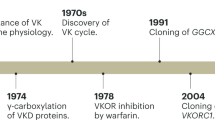Abstract
The association between vitamin K and hemostasis was first recognized by Dam in the late 1920s when he characterized 2-methyl-3phytyl-1,4-naphthoquinone or vitamin K1, as an antihemorrhagic factor for chicks. The structures of vitamin K1 and other compounds relevant to this discussion are shown in Figure 12-1. It was originally thought that the only defect in vitamin K deficiency was a lack of plasma prothrombin. During the 1950s it was recognized that there are a large number of plasma factors in addition to prothrombin associated with thrombin generation; subsequently factors X, IX, and VII were identified and shown to be vitamin K-dependent. A diagrammatic representation of the cascade model for blood coagulation as it is currently understood is shown in Figure 12-2. In this scheme, a series of proteins acts as substrates for proteases that convert them to active proteolytic enzymes, which then become the proteases of the next stage of the cascade. Knowledge of the cellular events responsible for the production of prothrombin, the role of vitamin K in this process, and its antagonism by coumarins has come largely from investigations spanning the last ten years. These studies have shown that prothrombin is formed in the liver by a vitamin K-dependent carboxylation of a liver precursor protein. This process and detailed information on the chemistry and activation of prothrombin have recently been reviewed,1 and only a limited number of specific references will be provided here.
Access this chapter
Tax calculation will be finalised at checkout
Purchases are for personal use only
Preview
Unable to display preview. Download preview PDF.
Similar content being viewed by others
References
Suttie JW, Jackson CM: Prothrombin structure, and biosynthesis. Physiol Rev 57: 1–70, 1977.
Shah DV, Suttie JW: Mechanism of action of vitamin K: evidence for the conversion of a precursor protein to prothrombin in the rat. Proc Nat Acad Sci USA 68: 1653–1657, 1971.
Garnot PO, Nilehn JE: Plasma prothrombin during treatment with Dicumarol. II. Demonstration of an abnormal prothrombin fraction. Scand J Clin Lab Invest 22: 23–28, 1968.
Josso F, Lavergne JM, Gouault M, et al: Differents etats moleculaires du facter II (promthrombine). Leur etude a l’aide de la staphylocoagulase et d’anticorps anti-facteur II. I. Le facteur II chez les subjets traites par les antagonistes de la vitamine K. Thromb Diath Haemorrh 20: 88–98, 1968.
Gitel SN, Owen WG, Esmon CT, et al: A polypeptide region of bovine pro-thrombin specific for binding to phospholipids. Proc Nat Acad Sci USA 70: 1344–1348, 1973.
Stenflo J: Dicumarol-induced prothrombin in bovine plasma. Acta Chem Scand 24: 3762–3763, 1970.
Stenflo J, Ferlund P, Egan W, et al: Vitamin K dependent modifications of glutamic acid residues in prothrombin. Proc Nat! Acad Sci USA 71: 2730–2733, 1974.
Nelsestuen GL, Zytkovicz TH, Howard JB: The mode of action of vitamin K. Identification of gamma-carboxyblutamic acid as a component of prothrombin. J Bio! Chem 249: 6347–6350, 1974.
Esmon CT, Grant GA, Suttie JW: Purification of an apparent rat liver pro-thrombin precursor: characterization and comparison to normal rat prothrombin. Biochemistry 14: 1595–1600, 1975.
Grant GA, Suttie JW: Rat liver prothrombin precursors: purification of a second, more basic form. Biochemistry 15: 5387–5393, 1976.
Shah DV, Suttie JW: The vitamin K dependent in vitro production of pro-thrombin. Biochem Biophys Res Commun 60: 1397–1402, 1974.
Esmon CT, Sadowski JA, Suttie JW: A new carboxylation reaction. The vitamin K-dependent incorporation of H-14-CO3- into prothrombin. J Biol Chem 250: 4744–4748, 1975.
Esmon CT, Suttie JW: Vitamin K-dependent carboxylase. Solubilization and properties. J Biol Chem 251: 6238–6243, 1976.
Suttie JW, Hageman JM, Lehrman SR, et al: Vitamin K-dependent carboxylase. Development of a peptide substrate. J Biol Chem 251: 5827–5830, 1976.
Editor information
Editors and Affiliations
Rights and permissions
Copyright information
© 1982 John Wright · PSG Inc
About this chapter
Cite this chapter
Suttie, J.W. (1982). Prothrombin Biosynthesis—A Vitamin K-Dependent Reaction. In: Vitale, J.J., Broitman, S.A. (eds) Advances in Human Clinical Nutrition. Springer, Dordrecht. https://doi.org/10.1007/978-94-009-8290-1_12
Download citation
DOI: https://doi.org/10.1007/978-94-009-8290-1_12
Publisher Name: Springer, Dordrecht
Print ISBN: 978-94-009-8292-5
Online ISBN: 978-94-009-8290-1
eBook Packages: Springer Book Archive




